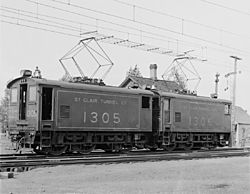St. Clair Tunnel facts for kids
 |
|
| View of the original tunnel (closed in 1994) from a 1907 postcard | |
| Overview | |
|---|---|
| Location | St. Clair River between Port Huron, Michigan and Sarnia, Ontario |
| Coordinates | 42°57′30″N 82°24′38″W / 42.95833°N 82.41056°W |
| Operation | |
| Closed | 1994 (first tunnel) |
| Operator | Canadian National Railway |
| Technical | |
| Length | 6,025 feet (1,836 m) (first tunnel) 6,129 feet (1,868 m) (second tunnel) |
| No. of tracks | Single (each tunnel) |
The St. Clair Tunnel refers to two different train tunnels. They were built under the St. Clair River. This river connects Sarnia, Ontario in Canada and Port Huron, Michigan in the United States.
The first tunnel opened in 1891. It was used until 1995. This original tunnel was the first full-size underwater tunnel in North America. "Full-size" means it was big enough for trains to pass through. It is now a special historic site in the United States. It is also recognized as an important civil engineering achievement by both Canadian and American engineering groups.
Contents
First Tunnel: 1891 to 1995
The first underwater train tunnel in North America opened in 1891. It was built by the St. Clair Tunnel Company. This company was part of the Grand Trunk Railway (GTR). The new tunnel helped GTR connect with its other train lines.
Before the tunnel, trains had to use ferries to cross the river. This took a lot of time. The tunnel made moving goods much faster.
Building the Tunnel
The tunnel was an amazing engineering feat for its time. It was designed by Joseph Hobson. New methods were created to dig in areas with compressed air. A special tool called the Beach tunnelling shield was used. It helped workers remove dirt and left a continuous iron tube. This tube was nearly 7,000 feet (2,100 m) long.
The tunnel measured 6,025 feet (1,836 m) from one end to the other. The St. Clair River itself is about 2,290 feet (698 m) wide at this spot. The tunnel tube was 19 feet 10 inches (6.05 m) wide inside. It had one standard gauge track. Building it cost about $2.7 million. Freight trains started using it first. Passenger trains began using it in 1892.
Tunnel Locomotives
At first, steam locomotives pulled trains through the tunnel. But people worried about smoke and fumes if a train stopped inside. So, in 1907, special catenary wires were added. These wires allowed electric trains to power through the tunnel.
The first electric locomotives started regular service on May 17, 1908. These powerful engines were built by Baldwin-Westinghouse. In 1923, the Canadian government took over the Grand Trunk Railway. They merged it into the new Canadian National Railway (CN). CN then took control of the tunnel and continued its operations.
The electric locomotives were retired in 1958. They were replaced by diesel-powered locomotives. Diesel engines did not create the same air quality problems in the tunnel. This meant the air inside was much cleaner.
Freight Car Sizes
After World War II, train cars in North America started getting much bigger. Canadian National (CN) had a problem. Some large freight cars, like hicube boxcars and automobile carriers, were too tall. They could not fit through the original tunnel.
So, CN had to use rail ferries again for these oversized cars. This was a slow and costly process.
Tunnel Recognition
The St. Clair Tunnel is a very important structure. In 1991, it was named a Civil Engineering Landmark. This recognition came from both Canadian and American engineering groups.
In 1993, the tunnel was declared a U.S. National Historic Landmark. This means it is a place of great historical importance in the United States. Canada also recognized its construction as a National Historic Event in 1992. A special plaque marks the site.
Second Tunnel: 1995 to Present
A second tunnel was built because the first one was too small. The new tunnel needed to handle modern trains. These trains often carry double-stacked shipping containers. These containers are very tall and could not fit through the old tunnel.
By the early 1990s, CN realized they needed a new tunnel. In 1992, the new CN president, Paul Tellier, saw that train traffic would increase. This was because of new trade agreements between Canada, the United States, and Mexico. More goods would be shipped, so a bigger tunnel was needed.
Building the New Tunnel
In 1993, CN started building the new tunnel. Paul Tellier said the tunnel would make CN a strong competitor in North American transportation.
Unlike the first tunnel, which was dug by hand, a special machine was used. This machine was called the Excalibore. It started digging on the Canadian side and bored its way to the U.S. side.
The new tunnel opened in late 1994. Freight and passenger trains stopped using the old tunnel. The old tunnel's entrance was then sealed. The new tunnel was officially dedicated on May 5, 1995.
New Tunnel Features
The new tunnel is 6,129 feet (1,868 m) long from end to end. Its inside is 27 feet 6 inches (8.38 m) wide. It also has a single standard gauge track. This larger size means it can fit all modern freight cars. Because of the new tunnel, the rail ferries were no longer needed. They were retired in 1994.
On November 30, 2004, CN renamed the new tunnel. It is now called the Paul M. Tellier Tunnel. This was done to honor Paul Tellier. He was the CN president who saw how important the tunnel would be. Signs with his name now hang over each tunnel entrance.
Images for kids






